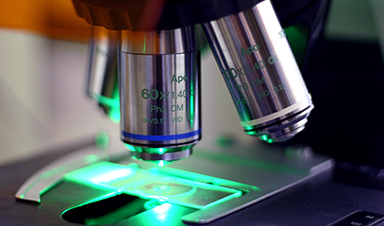Like our eyes, microscopes are limited in what they can see because of their resolution, or their ability to see detail. The detail, or information, from the object is there, but some of it gets lost as the light reflecting off of the object moves through the air.
“The whole premise of this is built on one single fact—the way light interacts with any matter is linear,” said Kamilov, assistant professor of electrical & systems engineering and computer science & engineering. “But the reality is that the interaction is actually not linear.”
For example, if you shine a flashlight through your hand, you can’t see the source of the light because it’s bending, and that is nonlinearity. With a single cell, the bending is so light that it is nearly transparent, which is linear.
When light interacts with a cell or an object, the light going out of the cell loses the information it gathers from that interaction. But because of that interaction, there are fluctuations in the vicinity of that cell that work with such matter and get retransformed and remitted. Those fluctuations are encoded into the nonlinearity of the interaction, but today’s microscopes are unable see this, Kamilov said.
“We want to take into account this nonlinear interaction of light, objects and premises, and if we do it correctly, we can extract that information, which normally disappears in a current microscope and is treated as ‘noise,'” Kamilov said. “We want to decode the information from the noise and add it back into the resolution, and that should give us features that are smaller than the resolution limit.”
Kamilov said there are two types of noise: imperfections and mathematical noise that is the result of science’s current limitations. It is the mathematical noise that he wants to capture.
Image Credit: Washington University in St. Louis
News This Week
Fever-Proof Bird Flu Variant Could Fuel the Next Pandemic
Bird flu viruses present a significant risk to humans because they can continue replicating at temperatures higher than a typical fever. Fever is one of the body’s main tools for slowing or stopping viral [...]
What could the future of nanoscience look like?
Society has a lot to thank for nanoscience. From improved health monitoring to reducing the size of electronics, scientists’ ability to delve deeper and better understand chemistry at the nanoscale has opened up numerous [...]
Scientists Melt Cancer’s Hidden “Power Hubs” and Stop Tumor Growth
Researchers discovered that in a rare kidney cancer, RNA builds droplet-like hubs that act as growth control centers inside tumor cells. By engineering a molecular switch to dissolve these hubs, they were able to halt cancer [...]
Platelet-inspired nanoparticles could improve treatment of inflammatory diseases
Scientists have developed platelet-inspired nanoparticles that deliver anti-inflammatory drugs directly to brain-computer interface implants, doubling their effectiveness. Scientists have found a way to improve the performance of brain-computer interface (BCI) electrodes by delivering anti-inflammatory drugs directly [...]
After 150 years, a new chapter in cancer therapy is finally beginning
For decades, researchers have been looking for ways to destroy cancer cells in a targeted manner without further weakening the body. But for many patients whose immune system is severely impaired by chemotherapy or radiation, [...]
Older chemical libraries show promise for fighting resistant strains of COVID-19 virus
SARS‑CoV‑2, the virus that causes COVID-19, continues to mutate, with some newer strains becoming less responsive to current antiviral treatments like Paxlovid. Now, University of California San Diego scientists and an international team of [...]
Lower doses of immunotherapy for skin cancer give better results, study suggests
According to a new study, lower doses of approved immunotherapy for malignant melanoma can give better results against tumors, while reducing side effects. This is reported by researchers at Karolinska Institutet in the Journal of the National [...]
Researchers highlight five pathways through which microplastics can harm the brain
Microplastics could be fueling neurodegenerative diseases like Alzheimer's and Parkinson's, with a new study highlighting five ways microplastics can trigger inflammation and damage in the brain. More than 57 million people live with dementia, [...]














Leave A Comment